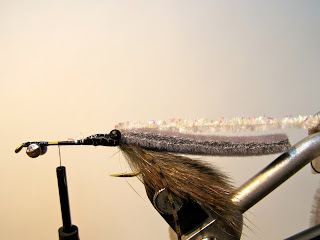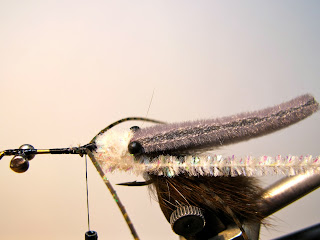I have been tying flies and playing around with a new camera. I don't consider myself to be a very talented fly tier (or picture taker for that matter), but the end results have a utilitarian purpose after all. So as I was in the cave lashing some animal by-products to Japanese steel I decided to snap a few photos. Here is one of my favorite crayfish patterns with (almost) step-by-step instructions. These are fun to tie and fish and a little more realistic than a standard woolly bugger. It's basically a Clouser Crayfish with fur claws instead of mallard breast feathers. I tie these in a size 4 TMC 5263 (nymph hook: 3x long, 2x heavy)... anything smaller and I typically go with a standard bugger.
As far as colors go... I try to match the shell back, hackle, rubber leg, and claw colors as close as possible. One thing that remains the same however is the white underside. I've messed with darker undersides but the white really seems to out fish ones with dark undersides.
Here is what you need:
Hook: TMC 5263
Weight: Dumb bell eyes
Claws: Pine Squirrel
Legs/Antennae: Sili-Leggs
Shell Back: Furry Foam
Eyes: Mono Eyes
Body: White Chenille
Hackle: Saddle or Neck to match the shell color.
Rib: 3x Mono
Here is how you do it:
1. Lash on the dumb bell eyes. I usually pre-assemble a bunch of these and glue them up once they are tied onto the hook.
2. Tie in your fur claws. These should be about 3/4 the length of the hook shank.3. Tie in Sili-Legg antennae (x2) about 2" long. They should be longer than the claws.
4. Cut a strip of Furry Foam about 3" long and tie on to the top of the hook shank extending off the back as shown. This should be cut about as wide as the hook gap (pre-cutting these helps).
5. Lash the Mono-Eyes as far back as possible on the top of the hook shank and Furry Foam.
6. Cut a 8" to 10" piece of chenille and tie onto the top of the hook.
7. As you begin to wrap your chenille push your mono eyes forward a bit. I usually double wrap the abdomen to get a thicker, more realistic profile.
8. After wapping back two widths of chenille, tie in Sili-Leggs about 2" long. Tie these to the side of the hook.
9. Make two more wraps of chenille and tie in another set of 2" Sili-Leggs to the side of the hook shank just like before.
10. After you tie in the legs, tie in your hackle and about 4" of 3x mono ribbing.
11. Leave the hackle and ribbing behind and complete wrapping the chenille forward to the hook eye. Tie off and trim the excess chenille away.
12. Wrap the hackle back to the eye, tie off, and trim the excess.
13. Pull the Furry Foam back to form the shell back. Pull it enough that the Mono-eyes stick out back at the hook bend. Secure the Furry-Foam to the hook, just behind the eye.
14. Counter-wrap the mono ribbing at even intervals and tie off behind the hook eye. By counter-wrapping you should be going opposite the direction that you wrapped the hackle and chenille- this makes a more secure body.
15. Whip finish and trip the excess furry foam.
16. You can leave it alone or color it to match the naturals. I like to keep some markers in my boat bag and color them on the river so that they match the color of the river bottom, like the naturals. I like burnt orange, dark olive, and slate-gray blue.
Usually I fish these on a sink tip and strip them along the bottom. They don't hang up as much as you might think. They can also be deadly dead drifted under a large (1") Thingamabobber.
Smallies attack these things with abandon, but don't over look throwing them (or dead drifting them) at trout- especially if your in an area where you suspect a large brown may be hanging out. On that note, I talked to Dan "Rooster" Levans out at the Stonefly Inn in Twin Bridges, Montana this past September and I asked him if the predicted "epic" hopper invasion ever materialized in Southwest Montana this summer. To his dismay, he said it didn't, too much rain, and the high country never dried out enough to push the hoppers down into the river valleys. He lamented that he only had one "real" hopper day all season, but in the same breath added that most of the big trout that were taken out of the Jefferson and Beaverhead were taken on... crayfish.
Maine rivers are loaded with crayfish and trout are trout whether they live in Maine or Montana. If the food is there, you better believe they will eat it. Throwing size 4 anythings as a salmonid generally won't keep your rod bent all day long with 12" stockers, but it might land you one of your better fish of the season. So don't be afraid to skip the size 12 Hornberg and try something different.
Tyler

















No comments:
Post a Comment